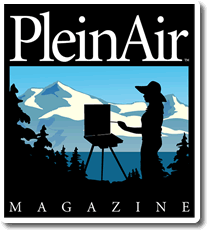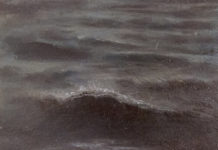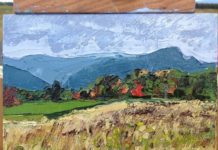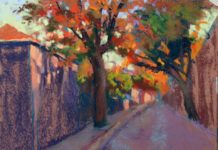Some people see a hole in the ground. Stewart White sees the fascinating world of people at work, big machines doing mighty things, and the play of light on a subject that acts as a great showcase for it.
“I like painting horse country, farmers’ markets, and things like that, but I try to find a quarry in the area when I’m in a plein air event,” says White. “A quarry is the most intriguing for me.”
White says he saw a quarry near his home in Baltimore from the highway, but a berm was blocking his view. “It kind of teases you,” he says. The artist drove around until he found the front entrance and asked if he could paint there. At first, the employees were confused by his request, but White showed them some of his work and explained what he wanted to do, and soon enough he was putting on steel-toed boots, a hard hat, and a safety vest and watching a mandatory video on quarry safety.
Inside the quarry, White discovered multiple reasons to like what he saw. As he suspected, the artist found light-colored stone that picked up the light in fascinating ways. This confirmed a thought he had after seeing some of John Singer Sargent’s paintings set in quarries. “Those pieces weren’t about the hillside or the people, but the way the light changes as it goes around the rock, the warm tones and cool tones, how they are keyed up high, and the great sense of light,” says White. “And I have seen some Daniel Garber paintings of stone, with just the abstract quality of cutting into the earth. It’s pure form, sometimes you can’t even tell what’s going on. A lot of things are just hooks to get you into the painting so you can enjoy the more abstract traits of it.” It’s not all about the whitish stones and shadows, though. White points out that quarries have standing water, sometimes in a shocking turquoise that implies some tinting from minerals in the mined rock.
Like many who were once boys, White also notices the impressive machines of the quarry. “The mammoth trucks — the scale of this operation — is really interesting to me,” he says. “I want to do more in painting the stairways and industrial machines, the cylinders and shadows they make, and show people for scale.”
And the truth is, this architect also just likes being around this kind of thing. “I have always liked scenes that show working people and construction,” White says. “I like the process of getting into the quarry and meeting the people — that is also part of the art for me. I really get into that.”
It’s unusual subject matter. Does it sell? ” Right now it’s just a labor of love,” says White. “Other artists appreciate them. Other people find them not that engaging because there isn’t a clear-cut subject in mind. But I’m opening a show in Cambridge this month and there are some paintings of quarries in it, so I’m curious to see what the response will be.”
(Due to the age of this post, some images may be missing from this article)




